This May Be the Last Time facts for kids
Quick facts for kids This May Be the Last Time |
|
|---|---|

Film poster
|
|
| Directed by | Sterlin Harjo |
| Produced by | Sterlin Harjo Christina D. King Matt Leach |
| Music by | Ryan Beveridge |
| Cinematography | Sterlin Harjo Shane Brown Matt Leach |
| Editing by | Matt Leach |
| Distributed by | Sundance Channel |
| Release date(s) | January 19, 2014 (Sundance Film Festival) |
| Running time | 90 minutes |
| Country | United States |
| Language | English Mvskoke |
This May Be the Last Time is a documentary film from 2014. A documentary is a movie that tells a true story or shows real events. This film was made by Sterlin Harjo, who was both the producer and director. It was first shown to the public at the Sundance Film Festival on January 19, 2014. After its first showing, the Sundance Channel bought the rights to show the film. It then premiered on TV in the spring of 2014.
Contents
The Story Behind the Film
The movie tells a special story about what happened in 1962. The director's grandfather, Pete Harjo, disappeared in a mysterious way. His car crashed on a bridge in the countryside near Sasakwa, Oklahoma.
A Community's Search
When Pete Harjo went missing, people from his community started looking for him. These were members of the Seminole and Muscogee tribes. As they searched, they sang old songs. These songs were full of faith and hope.
The Roots of the Songs
These special songs had been passed down through many generations. They had roots in two different kinds of music:
- Scottish Hymn Lining: This is a way of singing hymns where a leader sings a line, and then the group repeats it.
- African American Music: Many songs from African American traditions also influenced these tunes.
Who is Interviewed in the Film?
In the film, Sterlin Harjo talks to different people. He interviews members of his own family and other people from the local area. He also speaks with experts who know a lot about this topic. These experts include:
- Willie Ruff, a professor from Yale University.
- Hugh Foley, a professor from Rogers State University.
They help explain the history and meaning behind the songs and the community's traditions.

